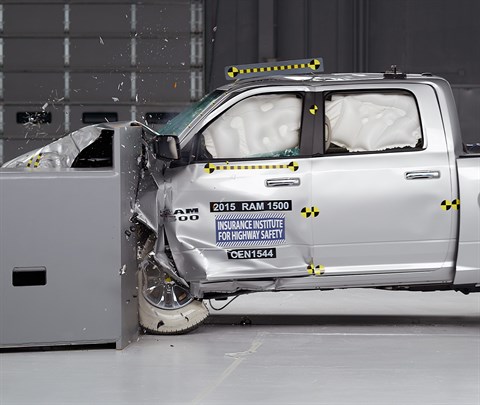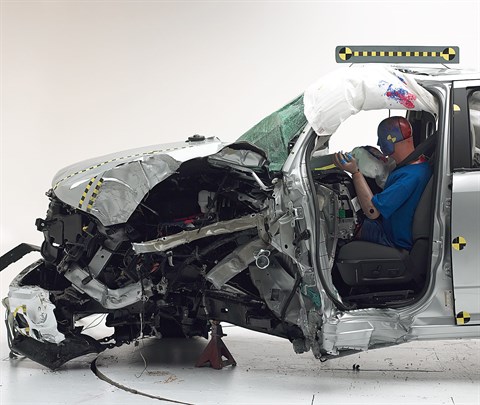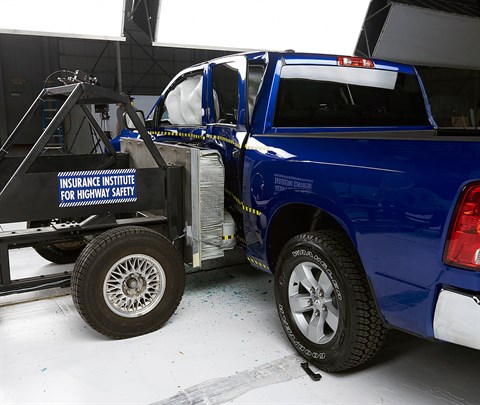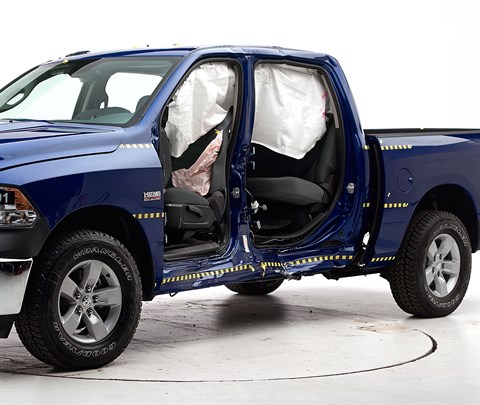Small overlap front: driver-side
Rating applies to 2015-18 models built after July 2015
Tested vehicle: 2015 Ram 1500 SLT Lone Star Crew Cab 2wd
The Dodge Ram 1500 Crew Cab was redesigned for the 2009 model year. The make name "Dodge" was officially changed to "Ram" beginning with the 2013 model year.
Beginning with 2015 models built after July 2015, structural changes were made to alter front wheel movement during small overlap frontal crashes. (Information about when a specific vehicle was manufactured is on the certification label typically affixed to the car on the driver door or adjacent B-pillar.)
| Evaluation criteria | Rating |
|---|---|
| Structure and safety cage | |
| Driver injury measures | |
| Head/neck | |
| Chest | |
| Hip/thigh | |
| Lower leg/foot | |
|
Driver restraints and dummy kinematics
The dummy’s movement was reasonably well controlled. The dummy’s face remained in contact with the frontal airbag, but its head still rolled around the left side as the steering column moved 13 cm to the right, leaving the head vulnerable to contact with forward structure. The side curtain airbag deployed and has sufficient forward coverage to protect the head from contact with side structure and outside objects. | |

Action shot taken during the small overlap frontal crash test.

The dummy's position in relation to the door frame, steering wheel, and instrument panel after the crash test indicates that the driver's survival space was not maintained well.

The dummy’s head contacted the frontal airbag but rolled around the left side as the steering column moved to the right, allowing the head to approach the intruding A-pillar.

Extensive intrusion of the door hinge pillar and instrument panel contributed to a high risk of injury to the left lower leg.
Moderate overlap front: original test
Rating applies to 2013-18 models
Tested vehicle: 2009 Dodge Ram 1500 ST Crew Cab 2wd
The Dodge Ram 1500 Crew Cab was redesigned for the 2009 model year. Frontal ratings are assigned by the Institute based on a test conducted by Chrysler. The make name "Dodge" was officially changed to "Ram" beginning with the 2013 model year.
| Evaluation criteria | Rating |
|---|---|
| Overall evaluation | |
| Structure and safety cage | |
| Driver injury measures | |
| Head/neck | |
| Chest | |
| Leg/foot, left | |
| Leg/foot, right | |
| Driver restraints and dummy kinematics | |
Side: original test
Rating applies to 2013-18 models
Tested vehicle: 2016 Ram 1500 ST Crew Cab 2wd
The Dodge Ram 1500 Crew Cab was redesigned for the 2009 model year. Beginning with 2009 models manufactured after September 2008, the front door trim panels were modified to improve occupant protection in side impact crashes.
Beginning with 2012 models manufactured after January 2012, side airbags designed to protect drivers' and front passengers' torsos were added to the side curtain airbags previously included. (Information about when a specific vehicle was manufactured is on the certification label typically affixed to the car on the driver door or adjacent B-pillar.)
The make name "Dodge" was officially changed to "Ram" beginning with the 2013 model year.
| Evaluation criteria | Rating |
|---|---|
| Overall evaluation | |
| Structure and safety cage | |
| Driver injury measures | |
| Head/neck | |
| Torso | |
| Pelvis/leg | |
| Driver head protection | |
| Rear passenger injury measures | |
| Head/neck | |
| Torso | |
| Pelvis/leg | |
|
Rear passenger head protection
The side curtain airbag deployed on the wrong side of the dummy's head, before the head had begun to move outward toward the rear passenger door. As a result, the head was hit by the pillar behind the door. This pillar is required by federal standard to provide some protection for occupants' heads. (The window glass, which remained intact during the crash, and the unpadded steel window frame were pulled away from the occupant compartment and did not hit the dummy's head.) | |

View of the vehicle and barrier just after the crash test.

View of the vehicle after the crash with doors removed, showing the side airbags and damage to the occupant compartment.

Smeared greasepaint shows where the driver dummy's head was protected from being hit by hard structures by the side curtain airbag.

The side curtain airbag deployed on the wrong side of the rear passenger dummy's head, and smeared greasepaint shows where the head was hit by the dislodged roof trim. The head was also hit by the pillar behind the rear door.
Roof strength
Rating applies to 2013-18 models
Tested vehicle: 2011 Dodge Ram 1500 ST Crew Cab 2wd
| Overall evaluation | |
|---|---|
| Curb weight | 5,186 lbs |
| Peak force | 15,412 lbs |
| Strength-to-weight ratio | 2.97 |
Head restraints & seats
Seat type: Power cloth seats
| Overall evaluation | |
|---|---|
| Dynamic rating | |
| Seat/head restraint geometry |
About the head restraint & seat test
Currently, IIHS tests apply only to front seats.
Headlights
Ratings are given for 3 different headlight variations available on this vehicle.
Trim level(s)
- Tradesmen trim
- Express trim
- Lone Star trim
- Big Horn trim
- Tradesmen HFE trim
- Outdoorsman trim
- SLT trim
| Evaluation criteria | Rating |
|---|---|
| Low-beam headlight type | Halogen reflector |
| High-beam headlight type | Halogen reflector |
| Curve-adaptive? | No |
| High-beam assist? | No |
|
Overall rating | |
| Distance at which headlights provide at least 5 lux illumination: | |
Low beams
On the straightaway, visibility was good on the left side of the road and inadequate on the right side. On curves, visibility was inadequate in all 4 tests.
The low beams never exceeded glare limits.
High beams
On the straightaway, visibility was good on the right side of the road and fair on the left side. On curves, visibility was fair on the gradual left and gradual right curves and inadequate on the sharp left and sharp right curves.
Trim level(s)
- Sport trim equipped with Convience Group package
- Laramie trim equipped with Convience Group package
- Laramie Longhorn trim equipped with Convience Group package
- Limited trim
| Evaluation criteria | Rating |
|---|---|
| Low-beam headlight type | Halogen projector |
| High-beam headlight type | Halogen projector |
| Curve-adaptive? | No |
| High-beam assist? | Yes |
|
Overall rating | |
| Distance at which headlights provide at least 5 lux illumination: | |
Low beams
On the straightaway, visibility was good on both sides of the road. On curves, visibility was inadequate in all 4 tests.
The low beams created excessive glare.
High beams
On the straightaway, visibility was good on the right side of the road and fair on the left side. On curves, visibility was fair on the gradual left curve and inadequate on the sharp left and both right curves.
High-beam assist compensates for some limitations of this vehicle's low beams on both left curves and on both right curves.
Trim level(s)
- Sport trim
- Laramie trim
- Rebel trim
- Laramie Longhorn trim
| Evaluation criteria | Rating |
|---|---|
| Low-beam headlight type | Halogen projector |
| High-beam headlight type | Halogen projector |
| Curve-adaptive? | No |
| High-beam assist? | No |
|
Overall rating | |
| Distance at which headlights provide at least 5 lux illumination: | |
Low beams
On the straightaway, visibility was good on both sides of the road. On curves, visibility was inadequate in all 4 tests.
The low beams created excessive glare.
High beams
On the straightaway, visibility was good on the right side of the road and fair on the left side. On curves, visibility was fair on the gradual left curve and inadequate on the sharp left and both right curves.
Child seat anchors
Rating applies to 2014-18 models
| Evaluation criteria | Rating |
|---|---|
| Overall evaluation | |
| Vehicle trim | ST Crew Cab |
| Seat type | cloth |
This vehicle has 2 rear seating positions with complete child seat attachment (LATCH) hardware.
It has 1 additional seating position with a tether anchor only.
| Evaluation criteria | Rating |
|---|---|
| Overall evaluation | |
| Vehicle trim | ST Crew Cab |
| Seat type | cloth |
| Rating icon | Rating |
|---|---|
| G | Good |
| A | Acceptable |
| M | Marginal |
| P | Poor |
| Seating positions that rely on borrowed lower anchors or have only a tether anchor available are not rated. | |
thether anchor symbol | Tether anchor |
lower anchor symbol | Lower anchors |
| Lower anchor(s) can be borrowed from adjacent positions(s) | |
| No hardware available |
Details by seating position
| Position | Rating |
|---|---|
| 1 | |
| Tether anchor | |
| hard-to-find location | |
| other hardware could be confused for anchor | |
| Lower anchors | |
| not too deep in seat | |
| not too much force needed to attach | |
| easy to maneuver around anchors | |
| 2 | |
| Tether anchor | |
| hard-to-find location | |
| other hardware could be confused for anchor | |
| Lower anchors | |
| none available | |
| 3 | |
| Tether anchor | |
| hard-to-find location | |
| other hardware could be confused for anchor | |
| Lower anchors | |
| not too deep in seat | |
| not too much force needed to attach | |
| easy to maneuver around anchors |
